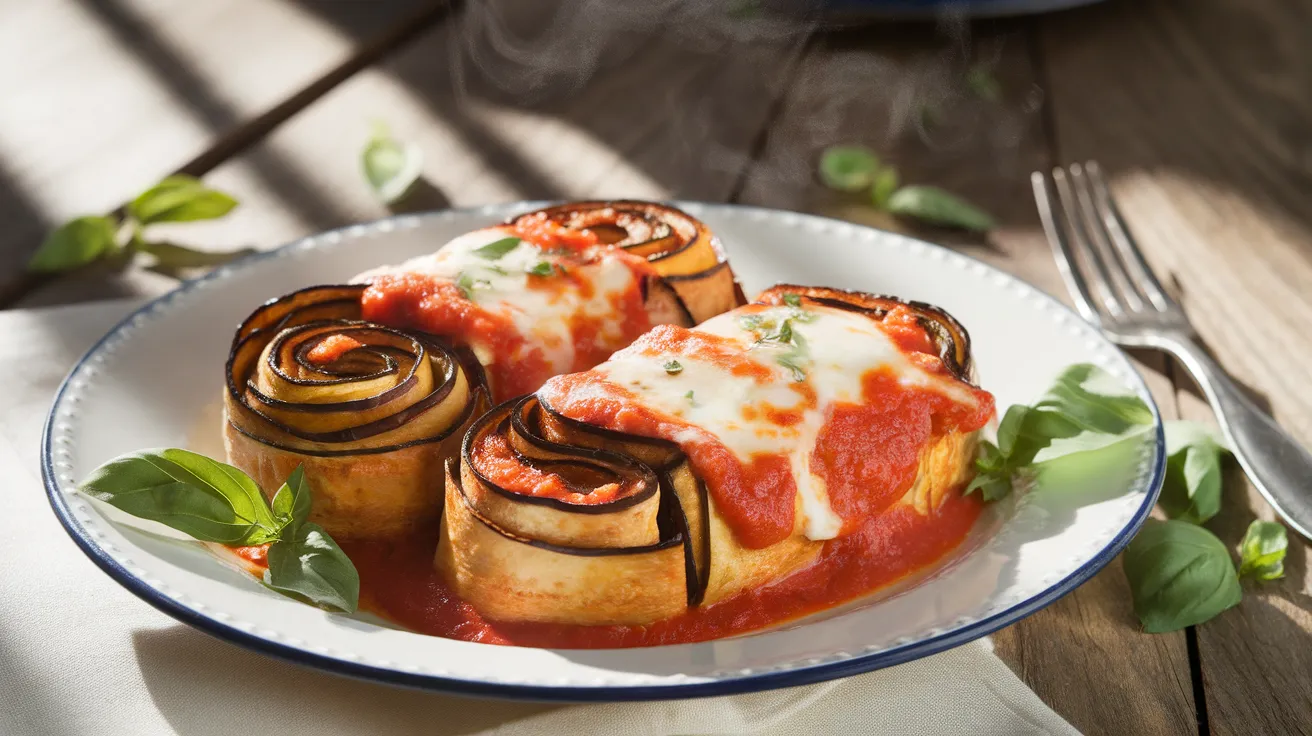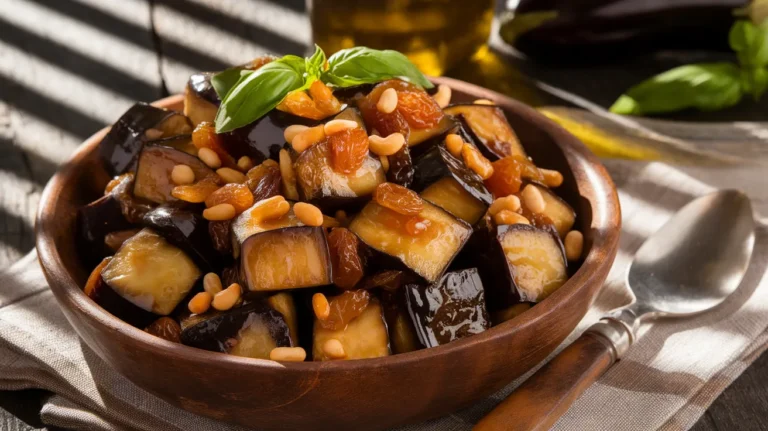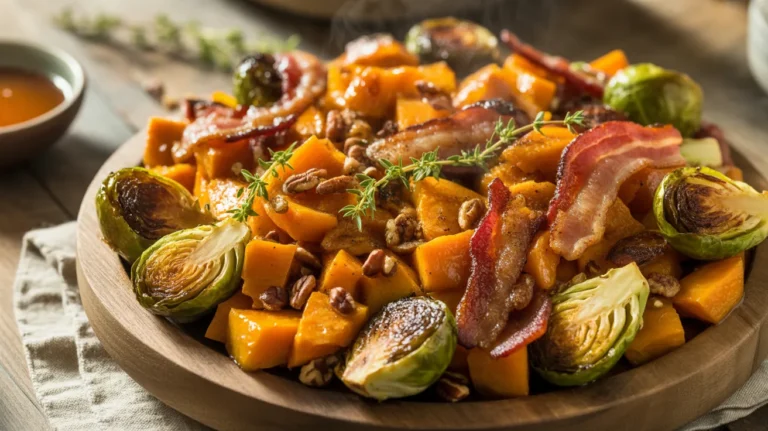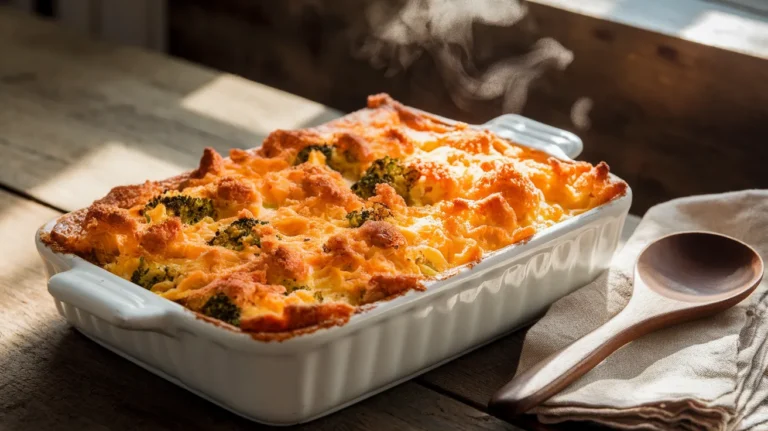Discover the ultimate eggplant rollatini recipe that transforms humble eggplant into restaurant-quality Italian comfort food. This classic dish features tender eggplant slices wrapped around creamy ricotta filling, topped with marinara and melted cheese. Perfect for family dinners or entertaining, this eggplant rollatini delivers authentic Italian flavors with every bite.
SERVES: 4 | PREP: 45 MIN | COOK: 35 MIN | TOTAL: 80 MIN
Ingredients
For the Eggplant:
- 2 large eggplants (about 2 lbs total)
- 2 tablespoons kosher salt
- 1 cup all-purpose flour
- 3 large eggs, beaten
- 2 cups Italian breadcrumbs
- 1/2 cup olive oil for frying
For the Ricotta Filling:
- 2 cups whole milk ricotta cheese
- 1 large egg
- 1/2 cup grated Parmesan cheese
- 1/4 cup fresh basil, chopped
- 2 cloves garlic, minced
- 1/2 teaspoon salt
- 1/4 teaspoon black pepper
For Assembly:
- 3 cups marinara sauce
- 2 cups shredded mozzarella cheese
- 1/2 cup grated Parmesan cheese
- 2 tablespoons fresh parsley, chopped
Step-by-Step Instructions
Phase 1: Preparing the Eggplant (20 minutes)
Step 1: Slice the eggplants lengthwise into 1/4-inch thick strips using a sharp knife or mandoline. You need about 12-16 slices total. The key is consistent thickness so they cook evenly.
Step 2: Lay eggplant slices on paper towels and sprinkle both sides generously with kosher salt. This draws out bitter moisture and prevents soggy rollatini. Let sit for 15 minutes.
Step 3: Pat eggplant slices completely dry with clean paper towels. Any remaining moisture will cause oil splattering during frying.
Step 4: Set up your breading station with three shallow dishes: flour in the first, beaten eggs in the second, and breadcrumbs in the third. This assembly line makes coating efficient.
Phase 2: Coating and Frying (15 minutes)
Step 5: Heat olive oil in a large skillet over medium-high heat. The oil is ready when a breadcrumb dropped in sizzles immediately but doesn’t burn.
Step 6: Dredge each eggplant slice first in flour, shaking off excess, then egg, letting excess drip off, and finally breadcrumbs, pressing gently to adhere. Work with one slice at a time for best results.
Step 7: Fry eggplant slices in batches, 2-3 minutes per side until golden brown. Don’t overcrowd the pan or temperature will drop. Transfer to paper towels to drain excess oil.
Step 8: Continue until all slices are fried and cooled. They should be tender when pierced with a fork but still hold their shape for rolling.
Phase 3: Making the Filling (5 minutes)
Step 9: In a medium bowl, combine ricotta cheese, egg, Parmesan, chopped basil, minced garlic, salt, and pepper. Mix until smooth and well combined.
Step 10: Taste the filling and adjust seasoning if needed. The mixture should be creamy but not runny, with bright herb flavors coming through.
Phase 4: Assembly and Baking (35 minutes)
Step 11: Preheat oven to 375°F. Spread 1 cup marinara sauce in the bottom of a 9×13-inch baking dish to prevent sticking.
Step 12: Place about 2 tablespoons of ricotta filling at one end of each eggplant slice. Roll carefully from the filling end, keeping the seam side down. Don’t overfill or the rolls will burst.
Step 13: Arrange rolls seam-side down in the prepared baking dish. They should fit snugly but not be crowded. Pour remaining marinara sauce over the top.
Step 14: Sprinkle mozzarella and Parmesan cheeses evenly over the sauce. Cover tightly with foil to prevent cheese from browning too quickly.
Step 15: Bake for 25 minutes, then remove foil and bake 10 more minutes until cheese is bubbly and lightly golden.
Step 16: Let rest for 5 minutes before serving. This allows the filling to set and makes serving easier. Garnish with fresh parsley.
Chef’s Notes
Eggplant Selection: Choose firm, heavy eggplants with smooth, shiny skin. Avoid those with soft spots or wrinkled skin, as they’ll be bitter and won’t hold their shape during cooking.
Oil Temperature Control: Maintain medium-high heat throughout frying. If oil gets too hot, breadcrumbs burn before eggplant cooks through. Too cool, and slices absorb excess oil.
Make-Ahead Magic: Assemble your eggplant rollatini up to 24 hours ahead, cover, and refrigerate. Add 10 minutes to baking time if cooking from cold.
Cheese Perfection: Use whole milk ricotta for creamiest texture. Low-fat versions can make the filling grainy and less satisfying in this rich dish.
Nutrition Information (Per Serving)
- Calories: 485
- Protein: 24g
- Carbohydrates: 38g
- Fat: 28g
- Fiber: 8g
- Sodium: 980mg
Creative Variations
Spinach & Ricotta Rollatini: Add 1 cup chopped frozen spinach (thawed and drained) to the ricotta filling for extra nutrition and color.
Meat Lover’s Style: Mix 1/2 cup cooked ground Italian sausage into the ricotta filling for a heartier version that meat lovers will devour.
Vegan Eggplant Rolls: Replace ricotta with cashew cream and nutritional yeast, skip the egg coating, and use dairy-free mozzarella. Just as delicious as the original.
Mediterranean Twist: Add sun-dried tomatoes, pine nuts, and fresh oregano to the filling. Serve with a drizzle of good olive oil and a sprinkle of feta cheese.
For more eggplant inspiration, try our crispy eggplant pizza or hearty eggplant sandwich recipes.
Storage & Reheating
Refrigerator Storage: Cover leftover eggplant rollatini tightly and refrigerate up to 3 days. The flavors actually improve overnight as they meld together.
Freezing Instructions: Wrap individual portions in plastic wrap, then foil. Freeze up to 3 months. Thaw overnight in refrigerator before reheating.
Reheating Method: Cover with foil and bake at 350°F for 20-25 minutes until heated through. Microwave individual portions for 1-2 minutes, though oven reheating maintains better texture.
Serving Temperature: Serve hot but not scorching. Let rest 5 minutes after reheating to prevent burns and allow cheese to set properly.
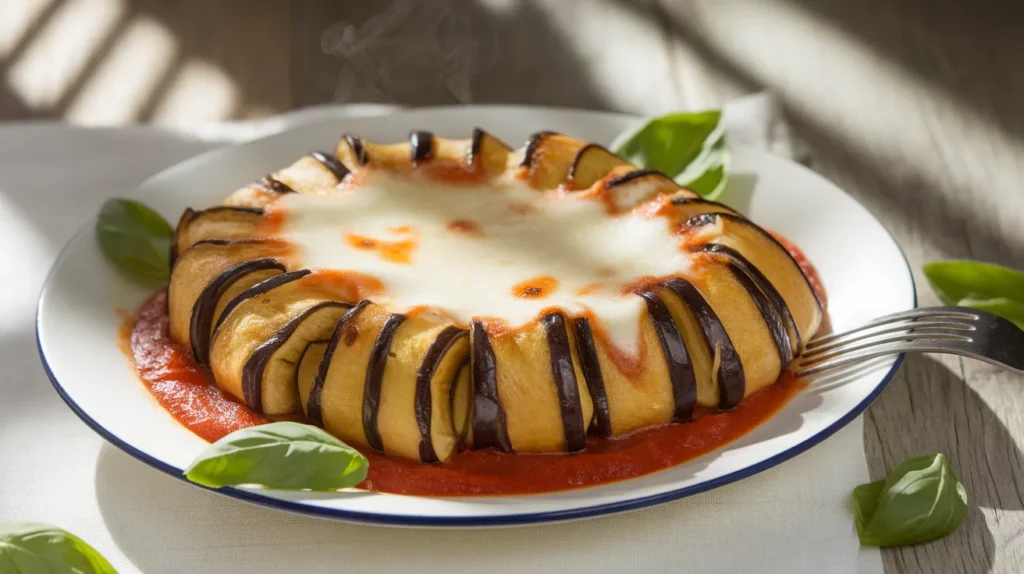
Troubleshooting Guide
Problem: Eggplant slices tear when rolling. Solution: Ensure slices are uniformly cut and properly salted. Fry until tender but not mushy. Let cool slightly before filling for easier handling.
Problem: Filling leaks out during baking. Solution: Don’t overfill rolls and place seam-side down. Use binding egg in filling and don’t make mixture too wet.
Problem: Breading falls off during frying. Solution: Pat eggplant completely dry after salting. Press breadcrumbs firmly and let coated slices rest 5 minutes before frying.
Problem: Rollatini tastes bitter. Solution: Salt eggplant properly and let sit full 15 minutes. Choose younger, smaller eggplants which tend to be less bitter.
Problem: Cheese burns before eggplant heats through. Solution: Cover with foil during most of baking time. Remove foil only for final browning. Lower oven temperature if needed.
Equipment Essentials
- Large sharp knife or mandoline slicer
- Paper towels for draining
- Three shallow dishes for breading station
- Large skillet for frying
- 9×13-inch baking dish
- Aluminum foil
- Medium mixing bowl
- Measuring cups and spoons
Shopping List
Produce Section:
- 2 large eggplants
- Fresh basil
- Fresh parsley
- Garlic
Dairy Section:
- Whole milk ricotta cheese
- Large eggs
- Mozzarella cheese (shredded)
- Parmesan cheese (grated)
Pantry Items:
- All-purpose flour
- Italian breadcrumbs
- Olive oil
- Kosher salt
- Black pepper
- Marinara sauce
Success Secrets
1. Salt your eggplant slices properly and give them the full 15 minutes. This step is crucial for removing bitterness and excess moisture that would make your rollatini soggy.
2. Keep your oil temperature steady at medium-high heat. Use a thermometer if needed – oil should be around 350°F for perfect golden browning without greasiness.
3. Don’t skip the resting time after baking. Those 5 minutes allow the cheese to set and the filling to firm up, making serving much cleaner and more attractive.
4. Use the seam-side-down rule religiously. This prevents unrolling during baking and keeps your beautiful presentation intact from oven to table.
5. Taste your ricotta filling before assembling. It should be well-seasoned since it’s the star flavor inside each roll. Adjust salt, pepper, and herbs to your preference before rolling.
